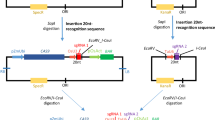Summary
The molecular basis for a shorter Cat2 transcript in maize lines null for the CAT-2 catalase iso/yme was investigated using cDNA libraries and genomic DNA blots. Sequence comparison of partial Cat2 cDNAs obtained from two CAT-2 null lines and a wild-type CAT-2 encoding cDNA showed that the Cat2 null transcripts diverged from the wild-type transcript but remained homologous to each other. Genomic DNA blots indicated that the missing portion of the transcript is present in the genomes of lines null for the CAT-2 isozyme. Differences in the hybridization patterns of normal and null lines were revealed when genomic DNA blots were probed with the full-length Cat2 cDNA, a Cat2 gene-specific probe, and a “null sequence” probe. Together, the DNA blotting results suggest that a rearrangement of the Cat2 gene has occurred in the CAT-2 null lines. The available data suggest that the CAT-2 null mutation in maize is due to a DNA insertion into the Cat2 gene.
Similar content being viewed by others
References
Aviv H, Leder P (1972) Purification of biologically active globin mRNA by chromatography on oligothymidylic acid-cellulose. Proc Natl Acad Sci USA 69:1408–1412
Bethards LA, Scandalios JG (1988) Molecular basis for the CAT-2 null phenotype in maize. Genetics 118:149–153
Bethards LA, Skadsen RW, Scandalios JG (1987) Isolation and characterization of a cDNA clone for the Cat2 gene in maize and its homology with other catalases. Proc Natl Acad Sci USA 84:6830–6834
Birnboim HC, Doly J (1979) A rapid alkaline extraction procedure for screening recombinant plasmid DNA. Nucleic Acids Res 7:1513–1523
Brawn K, Fridovich I (1981) DNA strand scission by enzymically generated oxygen radicals. Arch Biochem Biophys 206:414–419
Chandlee JM, Scandalios JG (1984) Analysis of variants affecting the catalase developmental program in maize scutellum. Theor Appl Genet 69:71–77
Chandlee JM, Tsaftaris AS, Scandalios JG (1983) Purification and partial characterization of three genetically defined catalases of maize. Plant Sci Lett 29:117–131
Chirgwin JM, Przybyla AE, McDonald RJ, Rutter WJ (1979) Isolation of biologically active ribonucleic acid from sources enriched in ribonucleases. Biochemistry 24:5294–5299
Feinberg AP, Vogelstein B (1983) A technique for radiolabeling DNA restriction enzyme fragments to high specific activity. Anal Biochem 132:6–13
Fucci L, Oliver CN, Coon MJ, Stadtman ER (1983) Inactivation of key metabolic enzymes by mixed-function oxidation reactions: possible implications in protein turnover and aging. Proc Natl Acad Sci USA 80:1521–1525
Gübler U, Hoffman BJ (1983) A simple and very efficient method for generating cDNA libraries. Gene 25:263–269
Kopczynski CC, Scandalios JG (1986) Cat2 gene expression: developmental control of translatable CAT-2 mRNA levels in maize scutellum. Mol Gen Genet 203:185–188
Maniatis T, Fritsch EF, Sambrook J (1982) Molecular cloning: a laboratory manual. Cold Spring Harbor Laboratory Press, Cold Spring Harbor/NY
Mead JF (1976) Free radical mechanisms of lipid damage and consequences for cellular membranes. In: Pryor WA (ed) Free radicals in biology, vol. 1 Academic Press, New York, pp 51–68
Norrander J, Kempe T, Messing J (1983) Construction of improved M13 vectors using oligodeoxynucleotide-directed mutagenesis. Gene 26:101–106
Redinbaugh MG, Wadsworth GJ, Scandalios JG (1988) Characterization of catalase transcripts and their differential expression in maize. Biochim Biophys Acta 951:104–116
Sanger F, Nicklen S, Coulson AR (1977) DNA sequencing with chain-terminating inhibitors. Proc Natl Acad Sci USA 74:5463–5467
Scandalios JG; Tong WF, Roupakias DG (1980) Cat3, a third gene locus coding for a tissue-specific catalase in maize: genetics, intracellular location, and some biochemical properties. Mol Gen Genet 179:33–41
Schleicher and Schuell, Inc. (1987) Transfer and immobilization of nucleic acids to S&S solid supports. Schleicher and Schuell, Inc.
Tsaftaris AS, Scandalios JG (1981) Genetic and biochemical characterization of a Cat2 catalase null mutant. Mol Gen Genet 181:158–163
Vayda ME, freeling M (1986) Insertion of the MuI transposable element into the first intron of maize Adh1 interferes with transcript elongation but does not disrupt chromatin structure. Plant Mol Biol 6:441–454
Author information
Authors and Affiliations
Additional information
Communicated by H. F. Linskens
Rights and permissions
About this article
Cite this article
Abler, M.L., Scandalios, J.G. The CAT-2 null phenotype in maize is likely due to a DNA insertion into the Cat2 gene. Theoret. Appl. Genetics 81, 635–640 (1991). https://doi.org/10.1007/BF00226730
Received:
Accepted:
Issue Date:
DOI: https://doi.org/10.1007/BF00226730




